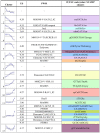Identification of cis-regulatory modules encoding temporal dynamics during development
- PMID: 24972496
- PMCID: PMC4097164
- DOI: 10.1186/1471-2164-15-534
Identification of cis-regulatory modules encoding temporal dynamics during development
Abstract
Background: Developmental transcriptional regulatory networks are circuits of transcription factors (TFs) and cis-acting DNA elements (Cis Regulatory Modules, CRMs) that dynamically control expression of downstream genes. Comprehensive knowledge of these networks is an essential step towards our understanding of developmental processes. However, this knowledge is mostly based on genome-wide mapping of transcription factor binding sites, and therefore requires prior knowledge regarding the TFs involved in the network.
Results: Focusing on how temporal control of gene expression is integrated within a developmental network, we applied an in silico approach to discover regulatory motifs and CRMs of co-expressed genes, with no prior knowledge about the involved TFs. Our aim was to identify regulatory motifs and potential trans-acting factors which regulate the temporal expression of co-expressed gene sets during a particular process of organogenesis, namely adult heart formation in Drosophila. Starting from whole genome tissue specific expression dynamics, we used an in silico method, cisTargetX, to predict TF binding motifs and CRMs. Potential Nuclear Receptor (NR) binding motifs were predicted to control the temporal expression profile of a gene set with increased expression levels during mid metamorphosis. The predicted CRMs and NR motifs were validated in vivo by reporter gene essays. In addition, we provide evidence that three NRs modulate CRM activity and behave as temporal regulators of target enhancers.
Conclusions: Our approach was successful in identifying CRMs and potential TFs acting on the temporal regulation of target genes. In addition, our results suggest a modular architecture of the regulatory machinery, in which the temporal and spatial regulation can be uncoupled and encoded by distinct CRMs.
Figures






Similar articles
-
Genome-wide identification of cis-regulatory motifs and modules underlying gene coregulation using statistics and phylogeny.Proc Natl Acad Sci U S A. 2010 Aug 17;107(33):14615-20. doi: 10.1073/pnas.1002876107. Epub 2010 Jul 29. Proc Natl Acad Sci U S A. 2010. PMID: 20671200 Free PMC article.
-
Molecular dissection of cis-regulatory modules at the Drosophila bithorax complex reveals critical transcription factor signature motifs.Dev Biol. 2011 Nov 15;359(2):290-302. doi: 10.1016/j.ydbio.2011.07.028. Epub 2011 Jul 28. Dev Biol. 2011. PMID: 21821017 Free PMC article.
-
De novo prediction of cis-regulatory elements and modules through integrative analysis of a large number of ChIP datasets.BMC Genomics. 2014 Dec 2;15:1047. doi: 10.1186/1471-2164-15-1047. BMC Genomics. 2014. PMID: 25442502 Free PMC article.
-
Identifying transcriptional cis-regulatory modules in animal genomes.Wiley Interdiscip Rev Dev Biol. 2015 Mar-Apr;4(2):59-84. doi: 10.1002/wdev.168. Epub 2014 Dec 29. Wiley Interdiscip Rev Dev Biol. 2015. PMID: 25704908 Free PMC article. Review.
-
Developmental mechanisms and cis-regulatory codes.Curr Opin Genet Dev. 2006 Apr;16(2):165-70. doi: 10.1016/j.gde.2006.02.014. Epub 2006 Feb 28. Curr Opin Genet Dev. 2006. PMID: 16503128 Review.
Cited by
-
Gene Regulatory Mechanisms Underlying the Spatial and Temporal Regulation of Target-Dependent Gene Expression in Drosophila Neurons.PLoS Genet. 2015 Dec 29;11(12):e1005754. doi: 10.1371/journal.pgen.1005754. eCollection 2015 Dec. PLoS Genet. 2015. PMID: 26713626 Free PMC article.
-
cis-regulatory analysis of the Drosophila pdm locus reveals a diversity of neural enhancers.BMC Genomics. 2015 Sep 16;16(1):700. doi: 10.1186/s12864-015-1897-2. BMC Genomics. 2015. PMID: 26377945 Free PMC article.
-
Ancient default activators of terminal photoreceptor differentiation in the pancrustacean compound eye: the homeodomain transcription factors Otd and Pph13.Curr Opin Insect Sci. 2016 Feb;13:33-42. doi: 10.1016/j.cois.2015.10.006. Epub 2015 Nov 14. Curr Opin Insect Sci. 2016. PMID: 27436551 Free PMC article. Review.
-
Genome-Wide Approaches to Drosophila Heart Development.J Cardiovasc Dev Dis. 2016 Jun;3(2):20. doi: 10.3390/jcdd3020020. Epub 2016 May 27. J Cardiovasc Dev Dis. 2016. PMID: 27294102 Free PMC article.
-
The role of transcription factors in the crosstalk between cancer-associated fibroblasts and tumor cells.J Adv Res. 2025 Jan;67:121-132. doi: 10.1016/j.jare.2024.01.033. Epub 2024 Feb 2. J Adv Res. 2025. PMID: 38309692 Free PMC article. Review.
References
Publication types
MeSH terms
Substances
LinkOut - more resources
Full Text Sources
Other Literature Sources
Molecular Biology Databases
Miscellaneous

